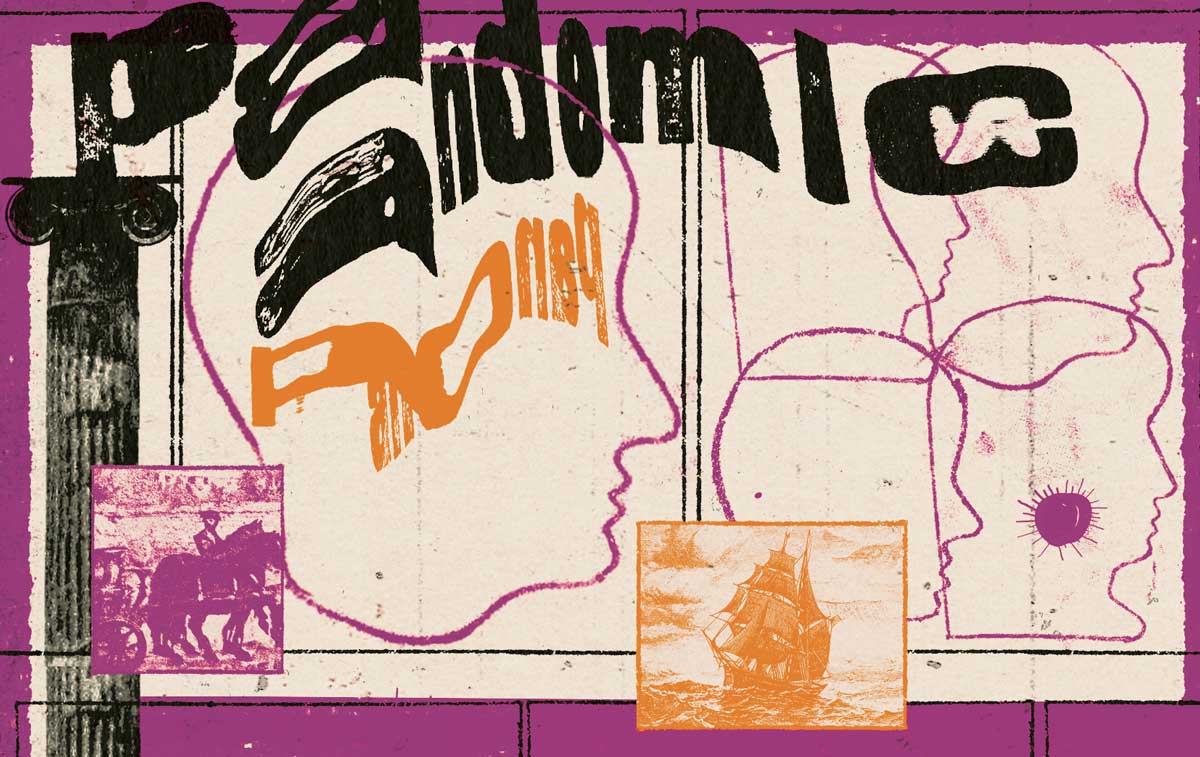Pandemics: Now and Then | History Today - 9 minutes read

The Greek roots of endemic, epidemic and pandemic give them a patina of scientific precision, which is misleading. The uses and connotations of the terms have changed radically over time and even today they lack crisp definition. In ancient Greek, pandemic meant ‘relating to all the people’, in the sense of vulgar. Pandemic music, for example, was popular music, more Beyoncé than Brahms. It was not a medical term and never became the vernacular word for a pestilence, which was loimos from the Iliad on. When the term pandemic (or ‘pandemick’) was revived in early modern science, it was often used as a synonym for epidemic, but with a sense closer to the current meaning of the word endemic, as a disease that is permanently established in a population, rather than one that suddenly falls upon a population.
Into the 19th century, pandemic and epidemic remained synonyms. In the 1828 edition of his dictionary, Noah Webster defined pandemic as ‘Incident to a whole people; epidemic; as a pandemic disease.’ (At the same time, the ‘k’ of ‘pandemick’ was lost as spelling became regularised, to the disappointment of people like Andrew Jackson, who sniped ‘It is a damn poor mind indeed which can’t think of at least two ways to spell any word.’)
Emerging paradigm
In the late 19th century, the definition of pandemic, with its now familiar connotations of ‘sudden’ and ‘geographically widespread’, came into focus. Two diseases above all are thought to have sharpened the distinction: cholera and influenza. Acute and highly contagious, they swept the globe in repeated waves, carried on expanding transportation networks. The emerging paradigm of germ theory made it easier to conceive of diseases as phenomena caused by specific, mobile agents. European imperialism gave birth to the fields of ‘medical geography’ and ‘tropical medicine’, allowing diseases to be imagined in planetary terms. The 1870s and 1880s saw the word pandemic used more widely and then, as David Morens, Gregory Folker and Anthony Fauci argued in 2009, the violent spread of the 1889-92 influenza pandemic brought the term ‘into general use’. By the time of the 1918 flu it was a ‘household’ word.
The rather forgotten pandemic of 1889-92 ‘came as a total surprise; there had been no major epidemic since 1847-8’. It raced around the world with stunning speed in an age of rail and steamship. Believed to have originated in Central Asia or Russia, it reached Western Europe and the US by late December. Patients suffered fever, chills, sweating, malaise and intense respiratory symptoms, progressing in some cases to pneumonia. Morbidity was high: estimates reckoned that half of France and almost half of Germany contracted the illness. Mortality fell disproportionately on the elderly. The first wave came and went quickly, but new waves of the disease returned the following two winters.
The causative agent of this pandemic is conventionally identified as influenza. This hypothesis rests on contemporary clinical descriptions, as well as the pattern of its diffusion and recurrence. The case for influenza remains strong. But it is worth calling attention to the suggestion, made by a group of geneticists more than a decade ago, that the pandemic of 1889-92 represents the emergence of a different respiratory virus: Human Coronavirus OC43.
This is one of seven species of the family coronavirus known to infect humans. It is a cousin of the current scourge, SARS-CoV-2. Infection with OC43 causes the common cold and it is one of the most widespread respiratory pathogens on the globe. It is also a very modern creature.
Microbiologists use a tool known as the ‘molecular clock’ to estimate the timing of evolutionary events, using the mutation rate to measure the amount of time it took for one strain or species to diverge from another. Such analysis dates the emergence of OC43 to around 1890; the pandemic of 1889-92 may have been the debut of this new coronavirus.
Relentless and recent
This ubiquitous pathogen emerged only 130 years ago, around the time the word pandemic came into popular currency. It underscores that the history of human disease is the story of relentless and recent pathogen evolution, driven by our own rapid and remorseless alteration of planetary ecologies.
As a Roman historian I have lost count of how often in recent months I have disappointed inquisitive journalists, hoping for juicier parallels from the fall of Rome. But the history of infectious disease does not offer ‘parallels’ or ‘instructive examples’, so much as perspective grounded in biological realism and the opportunity to deepen our sense of the pervasive and ongoing interplay between human social development and pathogen evolution.
Take, for example, the Antonine Plague, which struck the Roman Empire during the reign of Marcus Aurelius. The ancient texts date its outbreak to ad 166 and claim that it was dispersed throughout the Empire by armies returning from campaign in Parthia. It is notable that even though the Greeks and Romans lacked a medical equivalent to our word pandemic, the sources clearly and credibly describe one: a sudden, explosive and geographically widespread infectious disease event. Ancient sources depict a pestilence that struck ‘the world’, the ‘whole world’, the ‘entire army’. It ‘polluted everything with contagion and death, from the frontiers of Persia all the way to the Rhine and to Gaul’. In the words of a contemporary inscription, quoting the oracle of Apollo: ‘Many are the cities which are grieved at the wrathful displeasure of the gods.’ For the doctor Galen, an eyewitness, it was simply the ‘greatest’ and ‘longest-lasting’ pestilence. Remarkably, too, there are inscriptions from beyond the Empire, in Arabia, in years leading up to the Antonine Plague, testifying to a frightening mortality that swept ‘the whole land’.

It can be tempting to diminish the literary sources as hyperbolic or rhetorical, but they testify, independently and consistently, from every conceivable genre and point of view, through various media and languages, that this pestilence was a major event.
In other words, a pandemic was something unfamiliar. The societies comprising the Roman Empire bore a heavy burden of infectious disease at all times. Endemic diseases like malaria, tuberculosis, typhoid and a range of gastroenteric infections haunted the Roman population and were made worse by the urbanisation and connectivity that the Empire fostered. Life expectancy at birth was possibly in the low to mid-20s. As in any society where infectious diseases rule, the death rate fluctuated from season to season, year to year. If ancient Italy was like medieval Italy, then diseases such as malaria were both endemic and epidemic: a constant background presence, but capable of flaring up at intervals, when the weather promoted mosquito abundance, or harvest failure rendered hungry bodies susceptible to infection.
In a society that lived on thin margins and with virtually no effective biomedical interventions, people were accustomed to expect sharp interannual variations in mortality. Some years were sickly, others healthy. But explosive, geographically coordinated mortality events remained rare. Ancient chronicles and histories are not full of wild reports of global death. A comprehensive effort to retrieve all written testimony for epidemic disease in the Roman world, from the late Republic to the high Empire, finds only indications of regional mortality events. There was a pestilence across ‘nearly all of Italy’ in the year following Julius Caesar’s assassination, for example. But an episode as ideologically loaded and rhetorically rich as the killing of Caesar witnessed only a regional epidemic. We do not find florid accounts of widespread disease outbreaks or lurid descriptions of hideous symptoms. So, too, with every other epidemic for the next two centuries, until the Antonine Plague.
What pathogenic agent caused such a staggering disease event remains a point of frustrating uncertainty. The issue will remain ambiguous unless and until there is paleo-molecular evidence, as we now have for the Justinianic Plague. Given the speed, force and geographic scope of the Antonine Plague, the agent was probably a novel pathogen, introduced from outside the pool of diseases endemic in the ancient Mediterranean. The Antonine Plague was thus an event at the conjuncture of biological evolution and human structures, such as the trade networks that connected Roman producers and consumers to the world beyond. It was a pandemic avant la lettre, one of the first that we can follow in detail.
Genome sequencing
Even though we don’t know what germ caused the Antonine Plague, we are learning more about the evolutionary history of human pathogens from genome sequencing. In his Plagues and Peoples (1976), William McNeill established a narrative in which the Neolithic Revolution was the fulcrum of disease history. Sedentary lifestyles and domesticated animals allowed new diseases to establish in human populations across the Old World. These discrete disease pools then came into contact during the rise of the classical civilisations, with explosive consequences, such as the Antonine Plague. That story is not so much wrong as incomplete. With vast troves of genetic data now to hand, we can see much more clearly that wild animals (especially bats and rodents, but also primates and birds) have been a predominant reservoir of new infectious diseases and that the spin-off of evolutionary novelties has been a recurring pattern and source of instability in the history of human health.
The Roman experience, then, offers not lessons but perspective. The growth of human numbers (300 million at the time of the Antonine Plague, now racing towards eight billion) is part of a long-term acceleration of human expansion and exploitation of the planet. As we multiply, we broaden our exposure to potential new pathogens and increase the payoff for infecting us. Our current pandemic is part of this deeper pattern. The history of infectious disease does help us see why it should not have been a surprise. Like a tornado on the Oklahoma plains come springtime, a pandemic such as this one was inevitable, though hard to forecast precisely. It won’t be the last.
Kyle Harper is Professor of Classics and Letters at the University of Oklahoma and author of The Fate of Rome: Climate, Disease and the End of an Empire (Princeton, 2018).
Source: History Today Feed